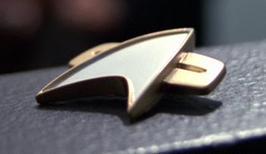Combadge
From Star Trek: Theurgy Wiki
The combadge was a combination of a badge and communicator, worn by Starfleet personnel on their uniforms during the 24th century. Variations of this form of device had been used on uniforms of other cultures at similar levels of technology also.
Combadges were used for onboard ship communication with other Starfleet personnel, when:
- Using the internal communication system was not possible or impractical
- For accessing the onboard computer when not in an area where the computer was listening
- For ship-to-shore communications
- For direct communication to another combadge
Transporters used the combadge to lock-on to its bearer to make transport faster. Combadges were fitted to act as a universal translator. Due to the size of the combadge, its working range was limited to 500 km, although a starship could boost the signal to bridge larger distances. For maintenance purposes, the combadge could be opened.
Personal Communicator
The current Starfleet-issue communicator represented the latest improvement in small subspace radio devices. Its primary role was to maintain voice contact among crew members aboard ship and during away missions and to provide a lock-on contact for transporter operations. Voice contact with other devices, such as the ship's main computers, was also within the communicator's capabilities.
The communicator casing was micro-milled duranium overlaid with gold and silver alloys in a diffusion-bonding process. The metal alloys served to compliment the aesthetic design of the device, which had been fashioned to resemble the Starfleet emblem.
Subspace Transceiver Assembly
The heart of the internal electronics was the Subspace Transceiver Assembly (STA). This circuit incorporated an analog-to-digital voice encoder and low-power subspace field emitter. It was also the same circuit used in devices such as the Personal Access Display Device (PADD) and the tricorder and shares the efficient data transmission protocols.
Voice inputs were received by a mono-film pickup diffusion-bonded to the inner casing and routed to the STA. While the standard STA possesses input channels for other data, these were not active in the communicator. As all Starfleet communications were normally encrypted, the voice signal pulses were converted by a series of encryption algorithms. These algorithms were changed on a random schedule by Starfleet Command for galaxy-wide subspace transmissions and individual starship codes could be substituted during local away missions.
Battery power was provided by a sarium krellide crystal rated for two weeks in normal use. When close to depletion, the crystal would produce a faintly audible oscillation; it could be returned to full power by induction recharging.
Communicator Control
Control of the personal communicator while aboard a Starfleet vessel was a matter of preference and habit. To initiate a voice call, it was simply a matter of tapping the front of the badge to confirm to the STA that the message was meant to go out. This may seem redundant, as the intra-ship comm system was constantly monitoring and routing voice transmissions, but it was a good practice to learn. During away team missions, the tap was essential to conserve internal battery power. The tap activated a dermal sensor to relay a power up command to the STA.
The range of the communicator was severely limited, mainly due to the small size of the STA emitter and power supply. In transmissions between two stand-alone communicators, clear voice signals would propagate only 500 kilometers, this was a tiny fraction of the 40,000 kilometers required to contact an orbiting starship, so it was the starship that must become the active partner in order to receive the communicator's low power signals and transmit corresponding to the communicator's receiver.
User ID Security
For security purposes, the communicator was a personalized Starfleet device that could be programmed to respond to the individual crew member's bioelectrical field and temperature profiles using the built in dermal sensor. If an attempt was made to operate an appropriately programmed device by another crew member without security override authority, the communicator would fail to activate. During benign situations, security codes were changed every five days. During emergency situations or when away team members were involved in operations, codes were changed on a random schedule at least once every twenty-four hours.
Secondary Functions
Every time a communicator was activated, it conducted a health check upon the assigned crewmember. This check was very basic in nature and consisted mainly of vital signs and voice stress analysis. Should any anomaly be detected, the duty medical officer was alerted by the ship's computer.
The commbadge was configured to act as a universal translator but only while in range of shipboard computer systems or an available tricorder system.
If the casing of the commbadge was ever cracked, an emergency distress signal would be emitted.
As a symbol of membership to Starfleet, personnel that have resigned or have been relieved of duty must turn in their commbadge. The act of taking of one's combadge was symbolically representative of taking of one's uniform.
Disclaimer Notice
Combadge info used with permission of USS Wolff CO - granted Jan 30, 2017

